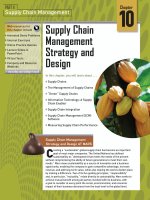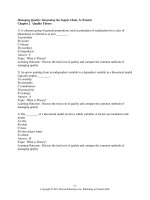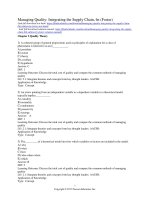Lecture Operations management: Creating value along the supply chain (Canadian edition) - Chapter 14S
Bạn đang xem bản rút gọn của tài liệu. Xem và tải ngay bản đầy đủ của tài liệu tại đây (490.57 KB, 26 trang )
OPERATIONS
MANAGEMENT: Creating Value
Along the Supply Chain,
Canadian Edition
Robert S. Russell, Bernard W. Taylor III, Ignacio Castillo, Navneet Vidyarthi
CHAPTER 14
SUPPLEMENT
Linear Programming
Supplement 14-1
Lecture Outline
Model Formulation
Graphical Solution Method
Linear Programming Model Solution
Solving Linear Programming Problems with Excel
Sensitivity Analysis
Supplement 14-2
Linear Programming (LP)
A model consisting of linear relationships
representing a firm’s objective and resource
constraints
A mathematical modeling technique which
determines a level of operational activity in order to
achieve an objective, subject to restrictions called
constraints
Supplement 14-3
Types of LP
Supplement 14-4
Types of LP
Supplement 14-5
Types of LP
Supplement 14-6
LP Model Formulation
Decision variables
symbols representing levels of activity of an operation
Objective function
linear relationship for the objective of an operation
most frequent business objective is to maximize profit
most frequent objective of individual operational units
(such as a production or packaging department) is to
minimize cost
Constraint
linear relationship representing a restriction on decision
making
Supplement 14-7
LP Model Formulation
Max/min
z = c1x1 + c2x2 + ... + cnxn
subject to:
Constraints
a11x1 + a12x2 + ... + a1nxn (≤, =, ≥) b1
a21x1 + a22x2 + ... + a2nxn (≤, =, ≥) b2
:
an1x1 + an2x2 + ... + annxn (≤, =, ≥) bn
xj = decision variables
bi = constraint levels
cj = objective function coefficients
aij = constraint coefficients
Supplement 14-8
Highlands Craft Store
Resource
Requirements
Product
Bowl
Mug
Labor
(hr/unit)
1
2
Clay
(lb/unit)
4
3
Revenue
($/unit)
40
50
There are 40 hours of labor and 120 pounds of clay
available each day
Decision variables
x1 = number of bowls to produce
x2 = number of mugs to produce
Supplement 14-9
Highlands Craft Store
Maximize Z = $40 x1 + 50 x2
Subject to
x1 +
4x1 +
2x2
3x2
x1 , x2
Solution is x1 = 24 bowls
Revenue = $1,360
40 hr
120 lb
0
(labor constraint)
(clay constraint)
x2 = 8 mugs
Supplement 14-10
Graphical Solution Method
1. Plot model constraint on a set of coordinates in a
plane
2. Identify the feasible solution space on the graph
where all constraints are satisfied simultaneously
3. Plot objective function to find the point on
boundary of this space that maximizes (or
minimizes) value of objective function
Supplement 14-11
Graphical Solution Method
x2
50 –
40 –
4 x1 + 3 x2
120 lb
Objective function
30 –
Area common to
both constraints
20 –
10 –
0–
x1 + 2 x2
|
10
|
20
|
30
|
40
|
50
|
60
40 hr
x1
Supplement 14-12
Computing Optimal Values
x2
40 –
4 x1 + 3 x2 = 120 lb
30 –
+
+
+
-
x1 + 2 x2 = 40 hr
x1 +
x1
20 –
10 8–
0–
x1
4x1
4x1
-4x1
|
10
24 |
|
20
30
2x2
3x2
8x2
3x2
5x2
x2
=
=
=
=
=
=
40
120
160
-120
40
8
2(8) =
=
40
24
| x1
40
Z = $40(24) + $50(8) = $1,360
Supplement 14-13
Extreme Corner Points
x1 = 0 bowls
x2 = 20 mugs
Z = $1,000
x2
40 –
30 –
20 – A
10 –
0–
x1 = 224 bowls
x2 = 8 mugs
x1 = 30 bowls
Z = $1,360
x2 = 0 mugs
Z = $1,200
B
|
10
|
20
C|
|
30 40
x1
Supplement 14-14
Objective Function
40 –
x2
4x1 + 3x2 = 120 lb
30 –
Z = 70x1 + 20x2
20 –
10 –
Optimal point:
x1 = 30 bowls
x2 = 0 mugs
Z = $2,100
A
0–
B
x1 + 2x2 = 40 hr
|
10
|
20
| C
30
|
40
x1
Supplement 14-15
Minimization Problem
CHEMICAL CONTRIBUTION
Brand
Gro-plus
Crop-fast
Nitrogen (lb/bag)
2
4
Phosphate (lb/bag)
4
3
Minimize Z = $6x1 + $3x2
subject to
2x1 + 4x2
4x1 + 3x2
x1, x2
16 lb of nitrogen
24 lb of phosphate
0
Supplement 14-16
Graphical Solution
x2 14 –
x1 = 0 bags of Gro-plus
x2 = 8 bags of Crop-fast
Z = $24
12 –
10 –
8–
A
Z = 6x1 + 3x2
6–
4–
B
2–
0–
|
2
|
4
|
6
|
8
C
|
10
|
12
|
14
x1
Supplement 14-17
Simplex Method
Mathematical procedure for solving LP problems
Follow a set of steps to reach optimal solution
Slack variables added to ≤ constraints to represent unused
resources
x1 + 2x2 + s1 = 40 hours of labor
4x1 + 3x2 + s2 = 120 lb of clay
Surplus variables subtracted from ≥ constraints to represent
excess above resource requirement.
2x1 + 4x2 ≥ 16 is transformed into
2x1 + 4x2 - s1 = 16
Slack/surplus variables have a 0 coefficient in the objective
function
Z = $40x1 + $50x2 + 0s1 + 0s2
Supplement 14-18
Solution Points With Slack Variables
Supplement 14-19
Solution Points With Surplus Variables
Supplement 14-20
Solving LP Problems with Excel
Click on “Data”
to invoke “Solver”
Objective function
=C6*B10+D6*B11
=E6-F6
=E7-F7
Decision variables
bowls (X1) = B10
mugs (x2) = B11
=C7*B10+D7*B11
Supplement 14-21
Solving LP Problems with Excel
After all parameters and constraints
have been input, click on “Solve”
Objective function
Decision variables
C6*B10+D6*B11≤40
and
C7*B10+D7*B11≤120
Click on “Add” to
insert constraints
Click on “Options” to add
non-negativity and linear
conditions
Supplement 14-22
LP Solution
Supplement 14-23
Sensitivity Analysis
Sensitivity range for labor;
30 to 80 lbs.
Shadow prices – marginal
values – for labor and clay.
Sensitivity range for clay;
60 to 160lbs.
Supplement 14-24
Sensitivity Range for Labor Hours
Supplement 14-25









